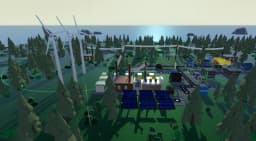One of the most rewarding parts of working on Power Network Tycoon is diving into real-world power engineering concepts and translating them into gameplay systems. Recently, I tackled one of the most ambitious features so far: supporting multiple power generators, implementing synchronisation mechanics, and simulating black start events. This feature pushed the simulation system to another level. It was also a time to reflect back on my undergraduate lab days where one class we needed to startup, synchronise and then close a generator onto a (disconnected) grid with a loud and satisfying thud sound. I was not allowed to see what happened if the generator was connected when not in-sync, which is where simulations come in.
Initially, the game was built with only one power generator. This was to keep the calculations simpler, and prevent impacts on performance. The game was never really about placing down a generator to fix all your power problems, as your problems went beyond managing the power once generated. Based on player feedback, I decided to add the ability to place multiple generators. This makes the game more true to life as in reality, there are multiple generators feeding into the grid, often located in different areas, each with their own ratings/ranks.
Pretty early into adding multiple generators, I realised it’s hard to show what’s going on when you have multiple generators on multiple networks. My UI was set to show visibility and control of “the network”, so I needed to set up code to only allow one network and if for some reason the network became split, the other (secondary) network wouldn’t run. When the split network was then re-formed into one, any power generators on the secondary network would need to be synchronised to the primary network.
In real power systems, generators need to be synchronised before connecting to the grid. That means matching frequency, voltage, and phase. To simplify things, If you connect an unsynchronised generator equipment can be destroyed as it puts extreme mechanical strain on any moving parts and a voltage difference where there shouldn’t be. In-game, I made a synchroscope with some visuals with LEDs showing the control panel and it feels a bit like a reaction time based “mini-game”. In the heat of the moment, when many things are occurring at once, this can get challenging with severe consequences if you do it wrong.
It was enjoyable to try to recreate these sound effects as well, because they are very niche for anyone to have on file.The main components were electrical arcing sounds mixed with car crash sounds, which pretty much reflects what’s going on.
One of my favorite features I’ve added is the black start scenario. If the grid goes down entirely, generally due to cascading effects/mistakes (partly occurring in New York in 2003 [1]), you must bring it back online from scratch and that’s very difficult. This means carefully starting up a black start capable generator, syncing additional generators one at a time, and gradually restoring parts of the grid. It’s a slow, deliberate process, and it feels really satisfying when you pull it off. I’ve made a video tutorial if you want to learn more.



